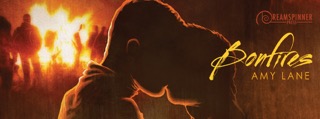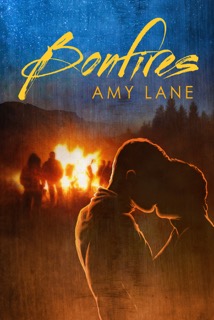A warm welcome to author Amy Lane joining us today to talk about newest release “Bonfires”.
Welcome Amy 🙂
Things That Are Real… Part 1
By Amy Lane
So, in the last two days, as people have read and (hopefully) enjoyed Bonfires, the flurry of questions has begun. I’m a storyteller at heart, and I chat enough on the blog and social media that people know something of my life. And since little bits and pieces of every author find their way into pretty much everything we write, they’re curious:
Which parts are “real”—or based on real experiences.
So I figured I’d make a list of things in my life that have sort of… added to the flavor of Bonfires. And, of course, longtime fans might see some similarities in other books as well.
The list is pretty extensive—but then, so is the blog tour, so if you’re interested, look around. You might find other parts of this list, or elaboration on parts of it, on the rest of the tour!
So here we go—
Things that Amy borrowed from her real life to put in Bonfires—
1—The family bonfire—
My dad was a suburb dweller—but he was smart. When chance and fateful cockup landed him on a piece of property with a crumbling house and a little bit of land, he planted a garden and started raising chickens and ducks to supplement his teeny tiny income. (This is actually another post on the tour!) My stepmom actually had experience on rural acreage, and she added expertise after they met.
At the end of the year, every year since I was a kid, the burning off of the garden was a ritual. In Placer County, there were designated burn days, probably in the interest of sparing the air and of not burning when it was especially windy. You had to have your pile ready to burn, because you could get fined for burning on an off day, and that would suck. We burned everything—leaves, feed sacks, garden detritus, warped lumber—everything went into the pile. On the one hand, it was a work day, and, well, ugh.
On the other hand, we really did roast marshmallows and hotdogs, and the whole family would stay, watching the fire, as night fell, and that really was pretty neat.
2—Small town football—
My hometown used to close up on homecoming, because we had the parade through the middle of town. The award winning marching band (which was my milieu) would play, and the homecoming royalty would ride convertibles through the center of time, smiling and waving like beauty queens. A lot of the townspeople were second, third, or fourth generation—entire families would attend the football games, even if it was just to see the light show the band put on.
And the light show? That was when we turned off the stadium lights, put lights in our helmets and a red light on our right spat and a blue light on our left, so we could march our competition show in the dark.
One year, we had a jackrabbit who bounded through the field once a game—he did it so regularly that one parent, whose kids were no longer in the band but who taught the kids in the band, held a sign up that said “Go Rabbit!”
Was there potential for a lot of bad there? Sure. But there was also a lot of good, and a lot of community—it all depended on who was captaining the ship.
3—Dealing with diversity in the hills
I attended a small town 90% white high school—and yes, getting out into the world and realizing, hey! That wasn’t the whole world? That was a shock. But then, because I tend to embrace new experiences, I ended up teaching on the whole other side of the city.
And I loved it.
Because my entire childhood and young adulthood, I’d yearned to get out of the microcosm that was the small town. I was sort of thrilled to realize that whole other life experiences existed less than forty miles away.
When I taught in Sacramento, one of my best friends in the staff room was the football coach—who was black and from Los Angeles, and he gave me a ration of friendly crap about my tiny white hometown on a daily basis. One day I walked into the staff room to ask how the away game had gone the Friday before, and Dennis was shaking his head, livid. Apparently our school had to play Nevada City—not my home school, per se, but in the same district. It gets cold up in Nevada City, and after dropping the students off, the bus driver saw a couple of flakes of snow—
And turned around, leaving our boys stranded at a school where they had just won the opposing team’s homecoming game.
Those students Dennis described, huddling under the gym and looking at all of the angry white people in absolute terror—those were my kids, and when I heard this story, I wanted somebody, anybody, in that school in the hills, to help them out. They made it home okay—no incidents to report—but I remember my kids telling me about how scared they were, and wishing better for them. They deserved so much better.
So when I mentioned that incident in the story, I was, in fact, fulfilling a wish for a class I had long ago. I wanted them to have a Larx and an Aaron when they were alone and afraid.
- Bruce the Snake
Bruce was not mine—but he was a real snake.
I had a friend—a science teacher—who had a Bruce. One day, during a fire drill, she came out of her classroom with Bruce looped over her wrist. She’d been washing him, because someone had dumped perfume over him, and he’d been fine at the time, but he could have died. He was a very sweet garter snake, and honestly, I used him as a model for Kane’s snake (a different variety of snake, but just as sweet) in Dex in Blue.
Bruce was a sweet snake, but sort of dumb—apparently snakes in captivity have trouble eating live prey, and Susan had to give him his mouse once a week and make sure he didn’t choke on it. One day, someone left the lid of his enclosure off, and he escaped, but our school had been built in the middle of a giant field. Every year we had an infestation of some kind—crickets, grasshoppers, mice. We had hopes that Bruce curled up in a corner under the building and at himself a lot of bugs, happy as a clam to be away from all the noise of the science room.
- Spaghilli
Okay—cooking is not my strong suit, I admit that, but Spaghilli was NOT my monster. It was my older daughter’s, (Chicken’s), after her father told her to make dinner one night. We had spaghetti, and he thought we had a can of sauce under the counter, but it turned out to be salsa, and she didn’t realize it until after she dumped it on the noodles. In an effort to, I don’t know, rectify the situation, she added two cans of chili to the mixture and the results were… well, pizza, because that’s what I went out and bought after I got home from dance lessons with the little kids.
I have to admit, it was still better than my oldest son’s cooking monstrosity—green bean and salami omelets, folks. Not even the dog would eat them.
Mate hasn’t made any hideous mistakes in the kitchen area—if he’s going to cook, he usually buys all the ingredients himself, but, my father’s attempts at clueless cooking are probably the most memorable.
When I was young, and we were living on food stamps, he used to buy white rice, cook it, and add ketchup. I swear to God I thought that’s what Spanish Rice was until my stepmom started cooking and saved both our lives. Honestly, the Spaghilli tasted better, true story.
Blurb:
Ten years ago Sheriff’s Deputy Aaron George lost his wife and moved to Colton, hoping growing up in a small town would be better for his children. He’s gotten to know his community, including Mr. Larkin, the bouncy, funny science teacher. But when Larx is dragged unwillingly into administration, he stops coaching the track team and starts running alone. Aaron—who thought life began and ended with his kids—is distracted by a glistening chest and a principal running on a dangerous road.
Larx has been living for his kids too—and for his students at Colton High. He’s not ready to be charmed by Aaron, but when they start running together, he comes to appreciate the deputy’s steadiness, humor, and complete understanding of Larx’s priorities. Children first, job second, his own interests a sad last.
It only takes one kiss for two men approaching fifty to start acting like teenagers in love, even amid all the responsibilities they shoulder. Then an act of violence puts their burgeoning relationship on hold. The adult responsibilities they’ve embraced are now instrumental in keeping their town from exploding. When things come to a head, they realize their newly forged family might be what keeps the world from spinning out of control.
Buy at
Amy Lane exists happily with her noisy family in a crumbling suburban crapmansion, and equally happily with the surprisingly demanding voices who live in her head.
She loves cats, movies, yarn, pretty colors, pretty men, shiny things, and Twu Wuv, and despises house cleaning, low fat granola bars, and vainglorious prickweenies.
She can be found at her computer, dodging housework, or simultaneously reading, watching television, and knitting, because she likes to freak people out by proving it can be done.
Connect with Amy:
Website: greenshill.com
Blog: writerslane.blogspot.com
Twitter: @amymaclane
Facebook group: Amy Lane Anonymous
Goodreads: goodreads.com/amymaclane
March 17 – MM Good Book Reviews
March 24 – Divine Magazine
March 27 – Scattered Thoughts and Rogue Words
March 27 – The Novel Approach
March 28 – Alpha Book Reviews
March 29 – Love Bytes
March 30 – Gay Book Reviews
March 31 – My Fiction Nook






Okay I really need to read this! I grew up on a farm in South Dakota where we regularly had bonfires, (best time ever!), attended a one room country school and a community high school (100% Scandinavians), went to high school football games (probably 2 a year the 4 years I attended) and killed a bull snake that was eating my duck’s eggs!
Such is life.
[…] in my last blog tour post, I talked about “things that are real”—things from Bonfires that had their roots in my real […]